“I believe, as you know… in the fundamental interconnectedness of all things. Furthermore I have plotted and triangulated the vectors of the interconnectedness of all things and traced them to a beach in Bermuda which it is therefore necessary for me to visit from time to time in the course of my investigations. I wish it were not the case, since, sadly, I am allergic to both the sun and rum punches, but then we all have our crosses to bear, do we not?”
– Douglas Adams (1987), Dirk Gently’s Holistic Detective Agency
Learning from Las Vegas
Las Vegas is the home of things that don’t belong.
After all, what business do the Eiffel Tower, the Great Pyramid, the Statue of Liberty, the Campanile di San Marco, and the Colosseum all have in the Mojave Desert? The transplantation of monuments, pools, and lush gardens to this desert oasis is one of the defining features of Las Vegas. It’s apropos that this city is also one of the very few places in the world outside of Madagascar where one can find the Malagasy tailless tenrec.
My RCN-Sponsored lab exchange allowed me to visit the lab of Frank van Breukelen to study the female reproduction of tailless tenrecs during their 2022 breeding season. The tenrec, while a lot like a hedgehog in appearance, is actually a member of the clade Afrotheria, the predominantly African mammals, and is more closely related to an elephant or aardvark than a true hedgehog. Tenrecs are notable for retaining a collection of what are believed to be ancient mammalian traits, such as having a cloaca, a widely variable body temperature, and seasonal torpor.
My research has investigated the evolution of mammalian pregnancy, and it just so happens that the tailless tenrec is an outstanding creature in its reproductive biology. This species is the world record holder for the largest litter size in mammals, producing up to 32 offspring from one reproductive bout, and has equally numerous lines of mammary glands to match. Their male genitalia also extends almost 70% of the length of their body, which allows fertilization to occur inside of the ovaries, something reported in few other mammals.
This makes them ideal points of contrast for evolutionary analyses of female reproduction. Afrotherian mammals like tenrecs have historically been sorely understudied in cellular and developmental biology in the so-called global north of North America, Europe and Asia, and yet they are essential to understanding the diversity and evolutionary history of mammals. Since so much of what we know about the decidua is limited to the human and common laboratory models of the mouse, rat, and livestock like pigs and cows, the opportunity to learn from the tenrec is exceedingly valuable.
The Project
Mammals evolved from an egg-laying ancestor, and a few species, the platypus and echidna, still lay eggs today. The rest of mammals are all live-bearing, but within them, not all pregnancies are the same. Marsupials have notoriously short pregnancies which give rise to underdeveloped offspring which must complete development within their eponymous pouch. On the other hand, a major evolutionary innovation seems to have enabled non-marsupial mammals, the true Placental mammals, to maintain and extended gestational period and produce precocial offspring.
That innovation was the origin of the uterine decidua – a transient, pregnancy-specific transformation of the endometrium comprising a constellation of specialized stromal and immune cells. Together, these cells orchestrate the process of embryo implantation and regulate the immunological milieu of the uterus. My PhD research has centered around three core decidua-specific cell types – the decidual stromal cell (a specialized fibroblast), the decidual-resident natural killer cell, and the decidual macrophage. My goal has been to elucidate how they arose in the evolutionary lineage leading to Placental mammals.
Knowing about the evolution of the decidua isn’t merely an academic curiosity: understanding reproduction to the point that we can intervene when it goes wrong, as with pregnancy complications and infertility, becomes possible only when we can find find tractable patterns in its overwhelming complexity. And a great wedge into that complexity comes from understanding how this process was pieced together over the course of evolution.
Going into the project, the only description of the decidual tissue of Tenrec ecaudatus I had to go from was collected by the German zoologist and explorer R.H. Goetz from a single female he excavated from the earth in Madagascar in 1931. Goetz produced a single black-and-white micrograph showing the unmistakable morphology of decidual cells, along with putative leukocytes, white blood cells that include macrophages, and lymphocytes, which could be natural killer cells – my 3 core cell types! Based upon this report, I designed and executed an experiment where we would study the uterus and placenta of timed-pregnant female tenrecs across a week-long period spanning ~26-33 days into the 60-day gestation of the species – a pretty safe bet at capturing the period of gestation which Goetz sampled.
The Execution
We had no surefire way to know whether a given female was actually pregnant. However, Gilbecca, the invaluable animal expert for this project, invented a method where the prospective mother is lifted into the air, and if her belly arches up in a curve, she is most likely carrying a litter. This test was accurate in 4 of 4 tries!
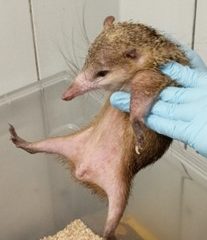
The pregnant uterus of Tenrec is two-horned, and each horn appears like a bunch of grapes, with the grapes corresponding to the sites where individual embryos have implanted into the uterus. Some of these implantation sites are substantially smaller than the others, and contain no visible fetus; these are likely sites of fetal resorption, or spontaneous pregnancy loss. In every specimen examined, there was at least one instance of fetal resorption, suggesting a remarkably high incidence for this species.
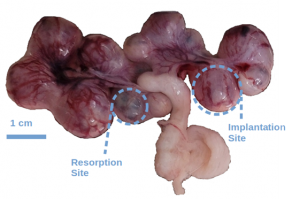
Plucking one of the grapes and opening it reveals a ruby-red disk of a placenta with with a greenish-brown hematophagic (“blood-eating”) zone in the middle. Below lies a pink region of maternal tissue which, if our hunch is correct, may have developed into a decidua.
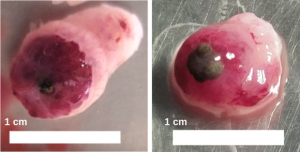
We collected some of these samples for basic histology to see what the cells at the fetal-maternal interface of this species look like in cross-section.
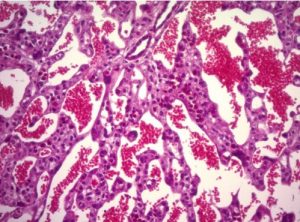
However, many cell types are indistinguishable by appearance alone, including decidual leukocytes. To truly characterize cell types, we needed to conduct single-cell RNA sequencing. This technique involves taking digesting an intact tissue to free its constituent cells from the extracellular matrix, and ultimately creating tiny nucleotide libraries of the genes being expressed in each cell.
The facilities to run this experiment were back home at Yale, so my approach was to do the dissection, pack up the tissue in hypothermic media (the same fluid used to keep organs alive for transplantation), and send it on a plane overnight from Las Vegas to New Haven. Back in New Haven, my intrepid colleague Jamie would receive these packages, complete the tissue digestion, and load the sequencer.
The crucial moment was the final count, when the cells are visualized under the microscope to see whether enough survived the journey. We use a dye which marks cells with holes in their plasma membrane blue, and leaves the living cells a pearly white. Upon arrival, I would receive a photo of the cells under the microscope back at Yale, and Jamie and I would have to make quick calculations and improvise interventions to bring them up to the right quality to sequence. My role felt a bit like being one of the engineers for a space mission, with a lot of uncertainty and quick problem solving around delicate physical events happening to objects sent far away from where I stood.
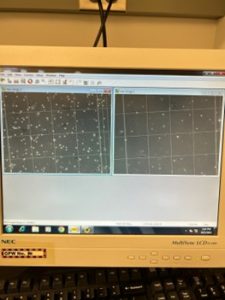
A shipping delay resulted in one package I sent getting held up for 24 hours in Nashville, Tennesee, and by the time it got to New Haven, too many of the cells had died to conduct meaningful sequencing. So, we had to scrub that mission. All of the other times, however, had complete success: a rate of 4 out of 5 isn’t bad at all!
Ash Meadows
To celebrate our early successes and muster up motivation for some more experiments the following week, my host professor Frank took me on a desert road trip to Ash Meadows National Wildlife Refuge. There, I got to experience the habitat of one of the other organisms his lab works on, the desert pupfish, in beautiful blue oases. I even got to watch some mammals – a family of bighorn sheep – go about their Sunday. We had a fun time with salty snacks and flavored seltzers in his pickup truck, and I got to savor the novel feeling of riding on long, straight highway surrounded by flat earth and mountains. That is something one cannot readily experience where I live in Connecticut.
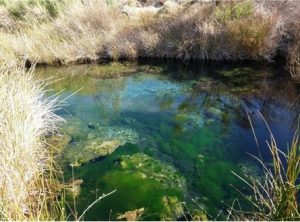
Improbability
At first, I couldn’t help but feel a bit absurd coming to a so-called “City of Sin” for research. It’s tempting for a student in my position to come here with a kind of affected detachment from the place. However, what I found was that the people living here seem to love it sincerely, don’t take life too seriously, and appreciate their city as a diverse crossroads of cultures. I left with a warm appreciation for the place and the University.
If “sin” is supposed to mean the violation of a sacred law, the law that was on my mind throughout this trip was the Second Law of Thermodynamics. That’s the law which states that the universe tends towards disorder. In other words, in order to get something really unlikely to happen, you have to put a lot of free energy into a system.
Something as absolutely unlikely as the sustained thriving and multiplication of tenrecs in an environment so far from their natal home is successful only with a prodigious input of free energy. On my exchange, I learned that this energy comes in the form of the labor of more than a dozen dedicated undergraduate and graduate students. To Zac, Raizel, Maria, Claudia, Deyna, Taylor, and most of all Gilbecca – your extraordinary dedication to the well-being of the tenrecs made all of these experiments possible, and your support and kindness made the trip memorable.
One day, I’m told, the sands of the Mojave Desert may once again swallow the Vegas Strip, and entropy will have its day. The tenrec colony that I had the privilege to visit may, like all others before it outside of Madagascar, collapse. But for this one beautiful, ephemeral, and thermodynamically improbable moment in human history, the Vegas skyline glimmers, the sole American Tenrec colony prospers, and I was given a chance to be a part of it. What a time to be alive!
Leaving Las Vegas
In closing, I leave you with the same words which a certain famous resident of Clark County, Nevada, used when reporting to the Senate his quick and decisive victory against Pharnaces II of Pontus in 47 CE:
veni vidi vici
As I write this now, I am left with small mementos to remember the trip – a card, and even a tenrec skull, which sits above my desk as I write this report.
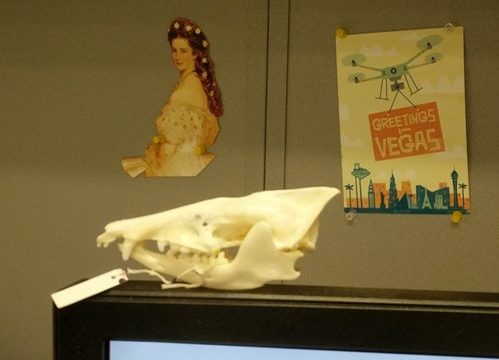
Thank you, Frank van Breukelen, for being an extraordinarily generous host and for so many engaging scientific discussions. Thank you Gilbecca, indispensable animal expert and colleague. Thank you to everyone responsible for the Research Coordination Network Exchange Program. Thank you David Lee for the kind extension of an invitation to give a seminar, and thanks to Katrina, Josh, and Justin for your conversations and company. Thank you to my advisor, Günter Wagner, for supporting this adventure. I came away from the exchange with fresh enthusiasm for my project and the possibilities for future research building on what I have begun there.